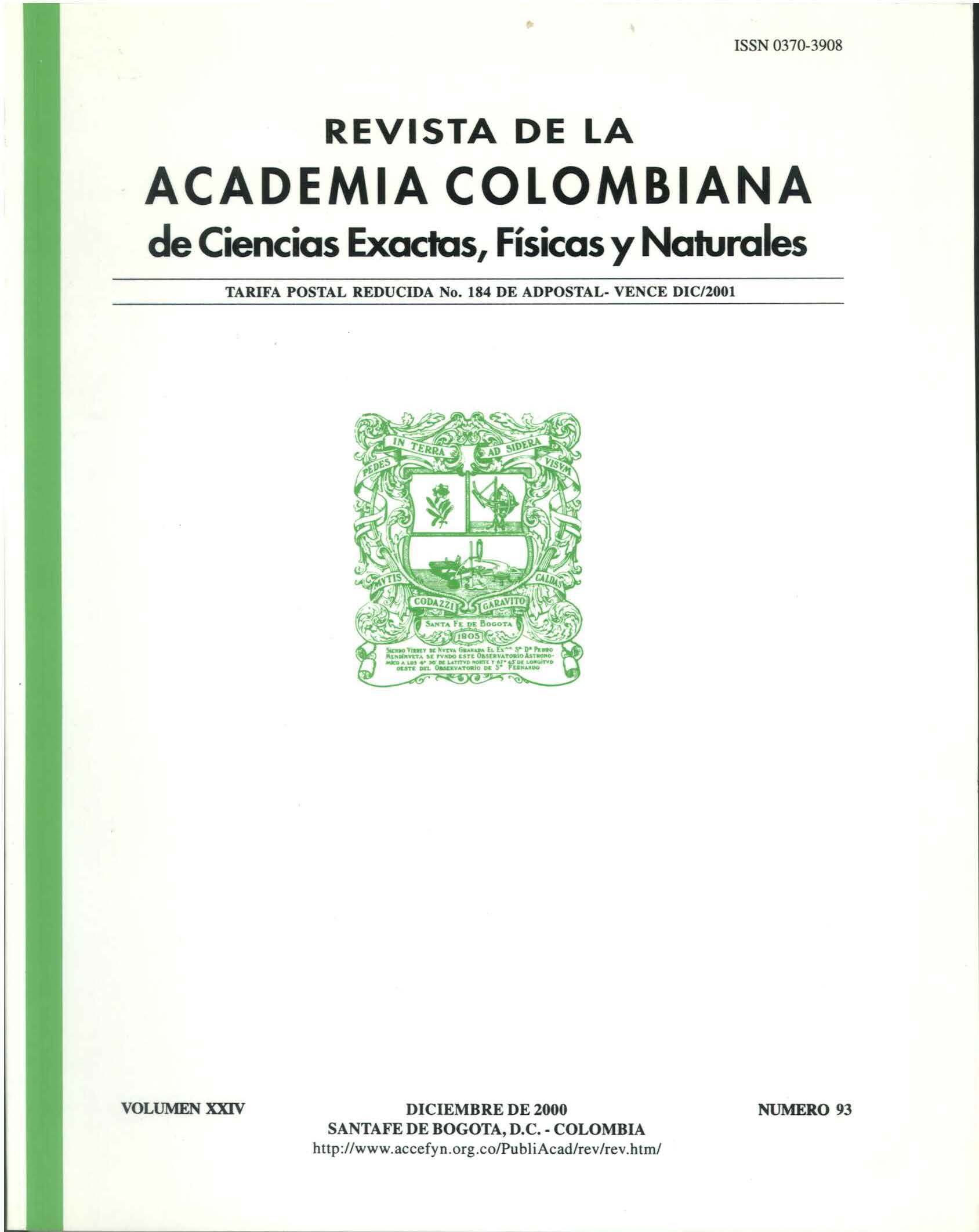Resumen
Herpetológicamente, el Guanía es el departamento menos conocido de Colombia; además, es de interés por su posición geográfica, entre los Llanos y los bosques del Amazonas. Adicionalmente, esta situado en el límite occidental de la región Guyana. Registramos 27 especies de ranas para el departamento (22 de ellas de los alrededores de la comunidad La Ceiba) y seguramente dos más también viven allá (hay registros de una localidad adyacente al Guainía). La fauna consiste en no menos que cuatro bufónidos, 11 hílidos, 11 leptodactílidos, dos microhílidos y un pípido. En esta contribución, reportamos cuatro especies de anuros para Colombia por primera vez: Aparasphenodon venezolanus (primer registro para el género en Colombia), Hyla ornatissma, Leptodactylus longirostris, y Osteocephalus oophagus.
Referencias
Caldwell, J. (1992). Diversity of reproductivc modes in anurans: facultative nest construction in gladiator frogs. Pp. 85-97. En W. C. Hamlett (Ed.), Reproductive Biology of South American Vertebrales. Springer-Verlag, New York.
Cochran, D.M. & C. J. Goin. (1970). Frogs of Colombia. United States National Museum Bulletin (288): t-655.
Duellman, W. E. 1978. The Biology of an Equatorial Herpetofauna in Amazonian Ecuador. The University of Kansas Museum of Natural History, Miscellaneous Publications (65): 1-352.
Duellman, W. E. 1997. Amphibians of La Escalera region, southeastem Venezuela: taxonomy, ecology, and biogeography. Sci. Pap., Nat. Hist. Mus. Univ. Kansas (2): 1-52.
Duellman, W. E. & R. Thomas. 1996. Anuran amphibIans from a seasonally dry forest in southeastem Peru and comparisons of the anurans among sites in the upper Amazon basin. Occas. Pap. Mus. Nat. Hist. Univ. Kansas (180): 1-34.
Duellman, W. E. & L. Trueb. 1986. Biology of the Amphibia. McGraw Hill Book Co., New York.
Heyer, W. R. 1974. Systematics of the marmoratus group of the genus Leptodactylus (Amphibia, Leptodactylidae). Contr. Sci. Los Angeles County Mus. (251): 1·50.
Heyer, W. R. 1978. Systematics of thefuscus group of the frog genus Leptodactylus (Amphibia, Leptodactylidae). Sci. Bull., Nat. Hist. Mus. Los Angeles County (29): 1-85.
Heyer, W. R. 1994. Variation within the Leptodactylus podjcipinuswagneri complex of frogs (Amphibia: Leptodactylidae). Smithsonian Contributions to Zoology (546): 1-124.
South American rocky habitat Leptodactylus (Amphibia: Anura: Leptodactylidae) with description of two new species. Proc. Biol. Soc. Wash. 108: 695-716.
Heyer, W.R. & W.F. Pyburn. 1983. Leptodactylus riveroi, a new frog species from Amazonia, South America (Anura: Leptodactylidae). Proc. Biol. Soc. Washington. 96: 560-566.
Hoogmoed, M.S. 1979a. Resurrection of the Hyla ornatissima Noble (Amphibia, Hylidae) and remarks on related species of green tree frogs from the Guyana area. Notes on the herpetofauna of Suriname VI. Zoologische Verhandelingen 172. Leiden. 46p.
Hoogmoed, M.S. 1979b. The Herpetofauna of the Guyanan Region. Pp. 241-279 En W. E. Duellman (ed.), The South American Herpetofauna: Its Origin, Evolution and Dispersa/. Museum of Natural History, University of Kansas Monograph No 7, Lawrence, Kansas.
Hoogmoed, M.S. 1990. Resurrection of Hyla wavrini Parker (Amphibia Anura: Hylidae), a gladiator frog from northern South America . Zoologische Mededelingen, Leiden 64(6): 71-93.
Paolillo, O.A. & J. Cerda. 1983 ("1981"). Nuevos hallazgos de Aparasphenodon venezolanus (Mertens) (Salentia, Hylidae) en el territorio federal Amazonas, Venezuela, con anotaciones sobre su biología. Memoria Sociedad de Ciencias de La Salle 41 (115): 77-95.
Seibert, E. A., H. B. Lillywhite & R. J. Wassersug. 1974. Cranial coossification in frogs: relationship to rate of evaporative water loss. Physiological Zoology 47: 261-265.
Señaris, J.C. & O. Vernet. 1997. Geographic Distribution (Amphibia). Hyla ornatissima. Herpetological Review 28: 207.
Rivero, J. A. (1961). Salientia of Venezuela. Bull. Mus. Comp. Zool. 126: 1-207.
Ruiz Carranza, P.M., M, C. Arcilla Robayo & J. D. Lynch. (1996). Lista actualizada de la fauna de Amphibia de Colombia. Rev. Acad. Colomb. Cienc. Ex. Fís. Nat. 20 (77): 365-415.
Trueb, L. & D.C. Canatella. 1986. Systematics, morphology, and phylogeny of genus Pipa (Anura: Pipidae). Herpetologica, 42(4): 412-419.
Trueb, L. & W. E. Duellman. 1971. A synopsis of Neotropical hylid frogs, genus Osteocephalus. Occas. Pap. Mus. Nat. Hist., Univ. Kans .. (1): 1-47.
Vélez-R, C. M. 1995. Estudio taxonómico del grupo Bufo typhonius (Amphibia: Anura: Bufonidae) en Colombia. Trabajo de grado. Universidad Nacional de Colombia.

Esta obra está bajo una licencia internacional Creative Commons Atribución-NoComercial-SinDerivadas 4.0.
Derechos de autor 2024 Revista de la Academia Colombiana de Ciencias Exactas, Físicas y Naturales

